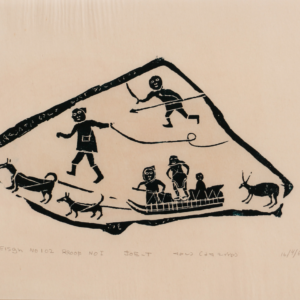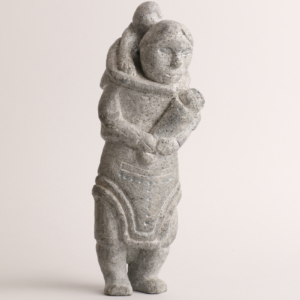Joe Talirunili ᔪᐅ ᑕᓚᕈᓂᓕ (1906-1976)
Joe Talirunilie was a remarkable artist who depicted the traditional life and culture of the Arctic. Born in 1906 at the Neahungnik camp, he grew up in the Kuujjuaraapik area and had a deep connection to the land and its ways of life. His experiences living in and travelling across Nunavik greatly informed his artwork, particularly his drawings and prints which often incorporated inscribed syllabics.
Talirunili’s focus on recording life in the Arctic as it was at the turn of the twentieth century reflects his commitment to preserving the stories and traditions of the past. His renowned series of carved boats, known as Joe’s Boats or the Migration series, serve as a poignant reminder of his childhood memories of a sea voyages across the Hudson Bay where he almost lost his life.
His art not only captures the physical landscapes and activities of the Arctic but also conveys the resilience, skills, and joy of Inuit life. Through his works, he has left a lasting testament to the old ways and the deep connections between the Inuit people and their environment.
“He left a legacy of sculpture, prints and drawings, which were unique in the way he crafted even the most mundane subject. His owls were horned ‘Joe’ owls, his human figures, animals and hunting scenes were instantly distinguishable, as were the haunting ‘migration’ boat scenes, whether rendered as drawings, prints or sculptures. Perhaps redundant as identification, but part of his enormous charm, was the inevitable ‘JOE’ (sometimes backwards) carved into his stones, almost as part of the image.
His contributions to editioned print collections started with the initial release in 1962 and continued without a break through the next 10 collections for a total of some 70 stonecut prints. He cut his own stones and probably tried his hand at printing, too, on occasion.” *)
Joe’s cousin, Davidialuk Alasua Amittu was also a renowned Puvirnituq artist. Their contributions as storytellers and artists have had a profound impact on the community of Puvirnituq and on the wider appreciation of Inuit art.
The fact that both men were prolific in both sculpture and graphic arts showcases their multi-dimensional talents and the depth of their artistic expression. Additionally, their role as co-founders of the Puvirnituq Co-operative in 1960 highlights their commitment to promoting and preserving Inuit art and culture within their community and beyond.
Their collaboration and artistic endeavors have undoubtedly enriched the cultural landscape of the Arctic and have helped to share and preserve the stories and traditions of the Inuit people.
*) Sandra Barz, “Canadian Inuit Print Artist/Printer Biographies” (New York: Arts and Culture of the North, 1990), page 65


